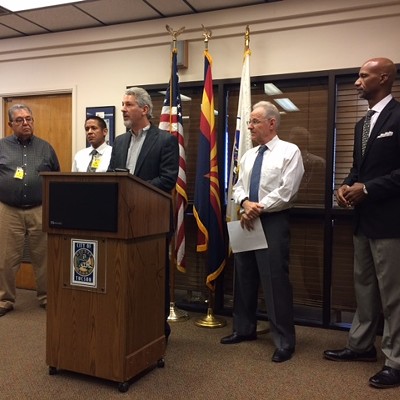Filed with the Pima County Recorder's Office, a "notice of trustee sale" is an early indicator of foreclosure proceedings. By the middle of this month, more than 600 had been recorded, almost equaling the 2008 total for all of March.
There were about 9,000 "notice of trustee sale" recordings in Pima County last year, a figure that doubled the 2007 total, and was three times higher than the approximately 2,850 notices filed in 2006.
At the current rate, nearly 3,000 notices will have been filed in Pima County through the end of March.
To try to deal with the national housing dilemma, President Obama recently announced a two-part mortgage-relief plan.
The program's first part would allow up to 5 million U.S. homeowners until June 2010 to refinance their loans to more affordable terms. Either Fannie Mae or Freddie Mac, which are sponsored by the government, must hold or guarantee these loans. To be eligible, owners can't owe more than 105 percent of their home's current value on their mortgage.
That limitation excludes many people who are "upside down" on their loans--meaning they owe more than the house is actually worth. Unfortunately, a huge number of homeowners in Pima County find themselves in that situation.
The other part of Obama's program, available through 2012, will decrease mortgage payments for up to 4 million U.S. homeowners. The mortgage-holder would voluntarily reduce the current mortgage payments to 38 percent of the household's income, and then the federal government and mortgage company would split the amount needed to bring it down to 31 percent.
"When I read the plan, I see a lot of good things," says Betty Villegas, Pima County's housing program manager. However, she adds that it is unknown how many distressed homeowners in Pima County would actually qualify.
Villegas thinks a majority of troubled mortgage holders in Tucson may be upside down on their loans. She also says that many homebuyers were spending around 45 percent of their income on their mortgages, according to numbers from 2006.
If that figure is still accurate, it could be quite expensive for mortgage companies to reduce payments to 38 percent of a household's income, and then split the amount with the federal government to bring it down to 31 percent.
One of the plan's components which Villegas supports the most is an annual $1,000 reduction in the mortgage principal for up to five years for participating homeowners who stay current on their mortgages.
Villegas also points out that lenders will receive a $1,000 incentive for each loan modification they make, plus $1,000 a year for three years for each involved mortgage holder who makes payments on time.
Despite those financial incentives, Mark Ross, president of the mortgage-brokerage firm Prime Capital, points out that a mortgage-holder does not have to participate in the second part of the president's program.
"The lenders will have to take a loss," he says about mortgage-holders agreeing to ultimately decrease monthly payments to 31 percent of the household income. "Are they willing to take (that loss), and will it be greater than if they did nothing?"
Ross expects that it will take time for lenders to understand how the two programs operate--a concern shared by Villegas. She says the enrollment process with a major lender was tested recently and found to be lacking.
"They could do this a lot smoother," she says of lenders involved with the program. "It needs to be more streamlined instead of depending (upon the knowledge) of who answers the customer's call."
Villegas also indicates there aren't any mechanisms in place to judge the success of the program. "There's nothing to gauge if it's working," she says.
Despite that and other uncertainties about the new program, Ross urges people to get involved. After all, it's better than facing foreclosure.
"The sooner they can get in touch with their mortgage company," he says of homeowners facing problems, "the more likely they are to be successful."
Regarding the constantly rising foreclosure rate in Tucson, Ross thinks it is likely that the community has entered a statistical "trough."
"We'll be several more months in this trough," he predicts, "until coming out of it."
Villegas optimistically hopes this year's total of "notice of trustee sale" recordings in Pima County won't exceed 9,000; at the current record pace, the total would reach 12,000.
Villegas stresses that in the past, only 48 percent of those notices have actually resulted in a foreclosure. The remainder, she says, are dealt with in several fashions: The loans may be modified; the home could go through a short sale under which the mortgage holder takes a loss; or the homeowner is left in limbo, awaiting some sort of resolution.
At the same time, Villegas concludes that things won't get better with foreclosures in Pima County "if we don't start putting people back to work. It's about people not having jobs," she says.












